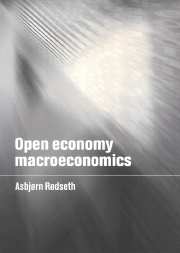9 - International interactions
Published online by Cambridge University Press: 06 July 2010
Summary
In the earlier chapters we have focused on a single open economy. Now it is time to look at how countries interact in the world economy. Again we start at the financial side and take a look at the international monetary system in section 9.1. In section 9.2 we go on to the real side and study shock transmission in a model based on chapter 6. Then we take a brief look at the arguments for international policy coordination in section 9.3, before we conclude (section 9.4) with some comments on the theory of optimal currency areas and on monetary unions.
The international monetary system
An exchange rate is a relative price between two currencies. Thus, both central banks cannot set the exchange rate independently. Furthermore, they both affect the exchange rate through interest rates and interventions. There has to be some division of labour between central banks; this division of labour, which must be based on some mutual understanding, is the international monetary system. It has taken many different forms during the twentieth century.
In the portfolio model of chapter 1 the foreign central bank played no explicit role. Before we go on, it is useful to extend the balance sheet from chapter 1 by dividing the foreign sector in two: the foreign private sector (subscript p*) and the foreign government/central bank (subscript g*), as is done in table 9.1.
- Type
- Chapter
- Information
- Open Economy Macroeconomics , pp. 287 - 322Publisher: Cambridge University PressPrint publication year: 2000



